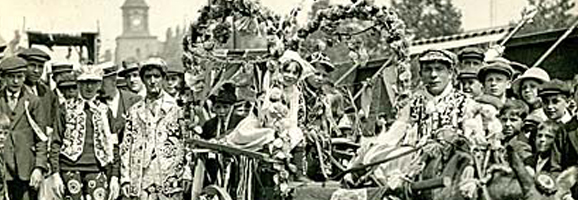
Ask many people what the East End means to them, and the chances are they will immediately think of the traditional side of that part of London – a London of Cockneys, Jellied Eels, Pie, Mash and Liquor and of the Pearly Kings and Queens. Whilst many of those traditions have been overwhelmed by the new influx of ‘EastEnders’, they still remain at the heart of East End culture. So – what is a cockney? – how did rhyming slang develop?- and how did the tradition of Pearly Kings and Queens begin? To find out – read on…
PEARLY KINGS AND QUEENS
Many people associate the East End with Pearly Kings & Queens. The Pearlies developed from the ‘Coster Kings & Queens’, who originated in the 18th century. The ‘Costers’ in turn began life as ‘Costermongers’, London’s street traders, who have (more)
COCKNEYS AND COCKNEY RHYMING SLANG
One question often asked in the East End is ‘What is a Cockney’? Well, a common definition of a cockney is a person who has been born within the sound of Bow bells. This has nothing to do with the suburb of Bow to the east of London but to the church of Saint Mary le Bow (more)
PIE, MASH AND LIQUOR
Due to the extremes of poverty in the East End, an inexpensive form of a hot nutritional meal was welcome, and supplies of eels was plentiful, right through until the end of the 1800’s – this formed the basis of Pie, Mash and Liquor (more)
THE GIN CRAZE
By the mid 1700’s, Londoners were drinking 112 pints of Gin – each – per year, and were caught in the middle of the Gin Craze that swept the country – the men and women of the East End were literally drinking themselves to death (more)
LIMEHOUSE OPIUM DENS
Opium Dens existed in Victorian Limehouse as Chinese sailors, predominately from Shanghai settled and created the first ‘Chinatown’ in the East End – but what is the truth about the real opium dens and what is fiction? (more)
THE BETHNAL GREEN TUBE DISASTER
In a few short seconds on the 3rd of March 1943, 173 people were crushed to death in the entrance to Bethnal Green Tube Station. 27 men, 84 women and 62 children perished in the worst civilian disaster of the Second World War (more)
THE SILVERTOWN EXPLOSION
A little before 7pm on the evening of Friday the 19 January 1917, with Britain firmly in the grip of WWI, Silvertown in East London was shattered by a huge explosion. The blast flattened much of the surrounding East End (more)
